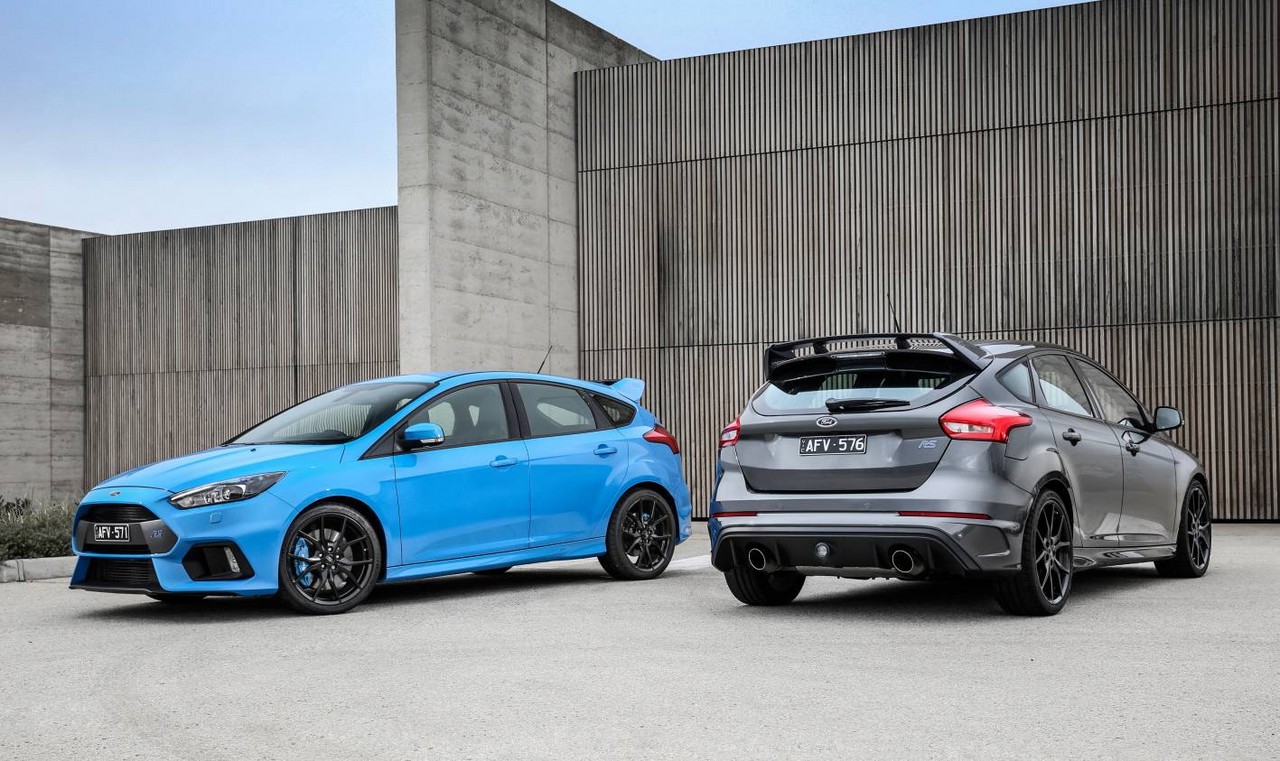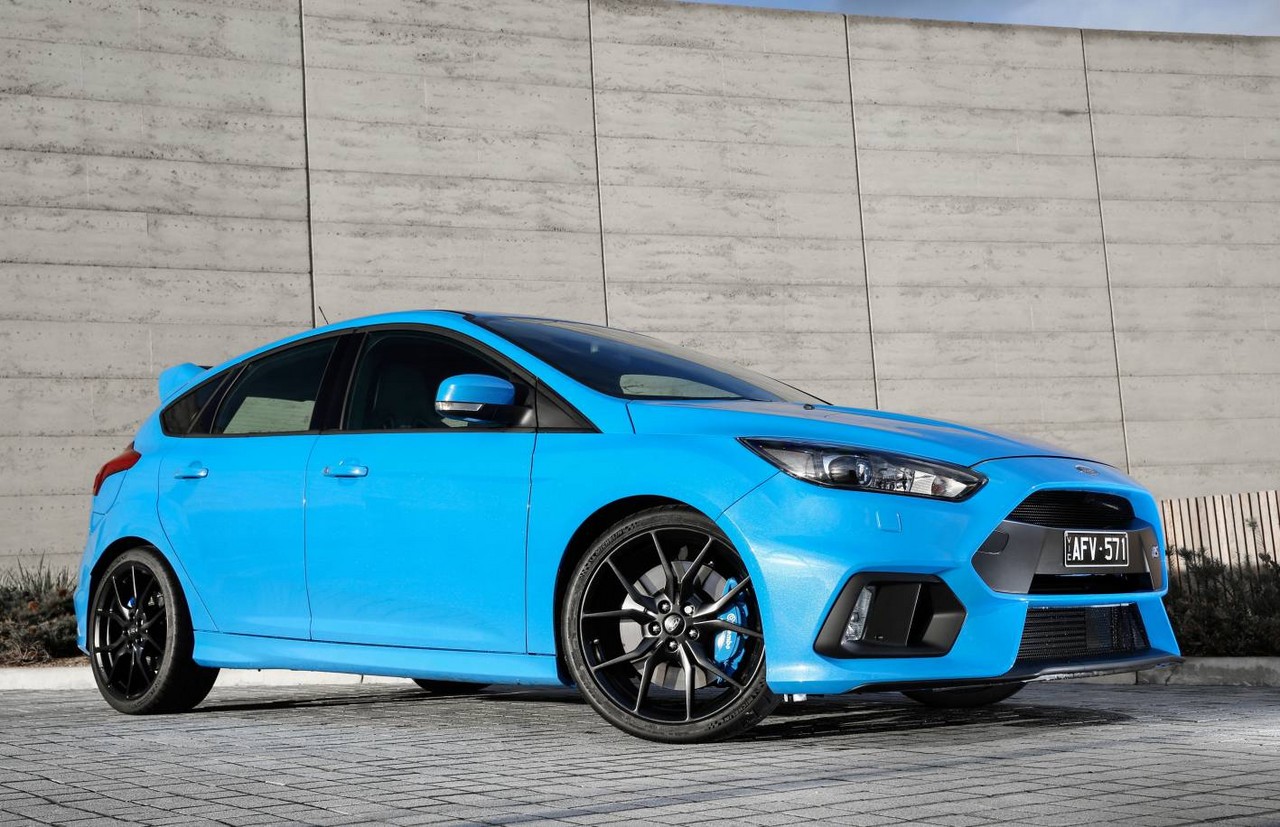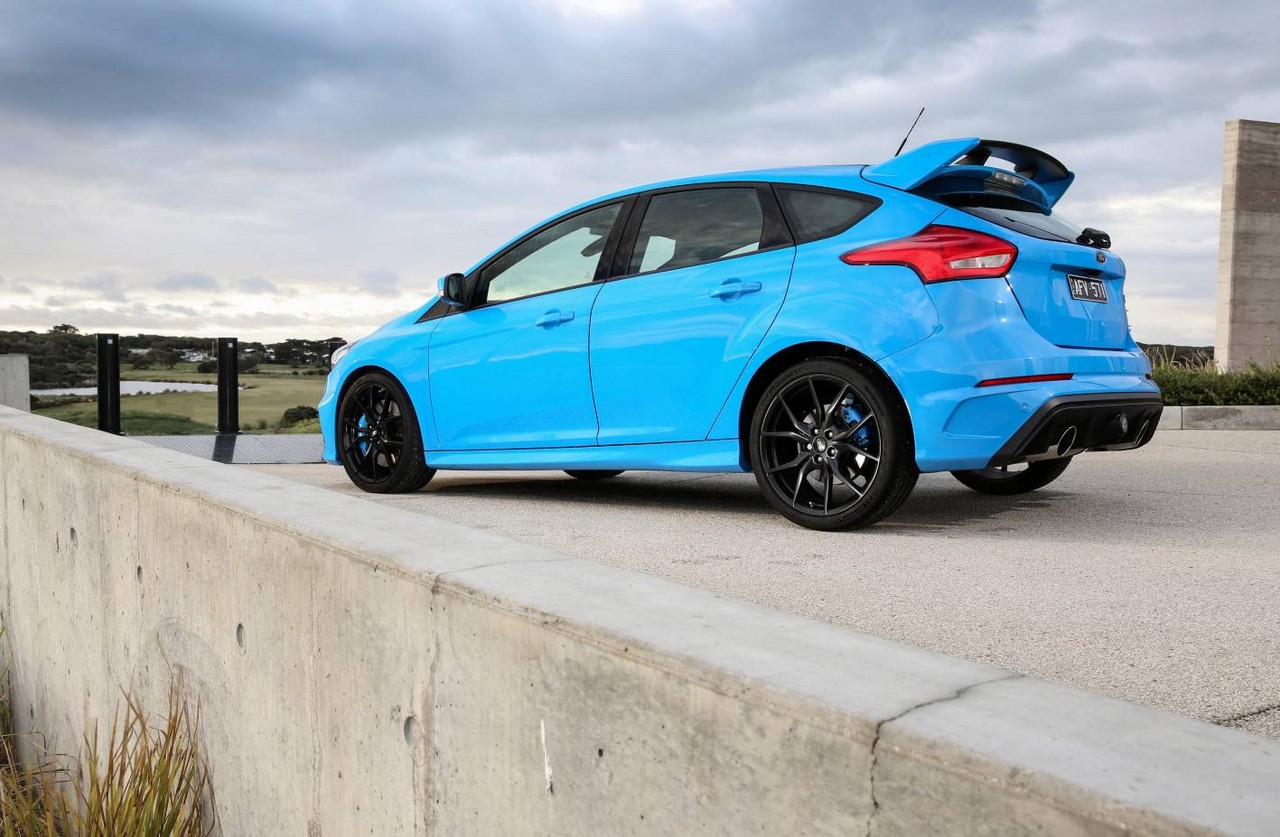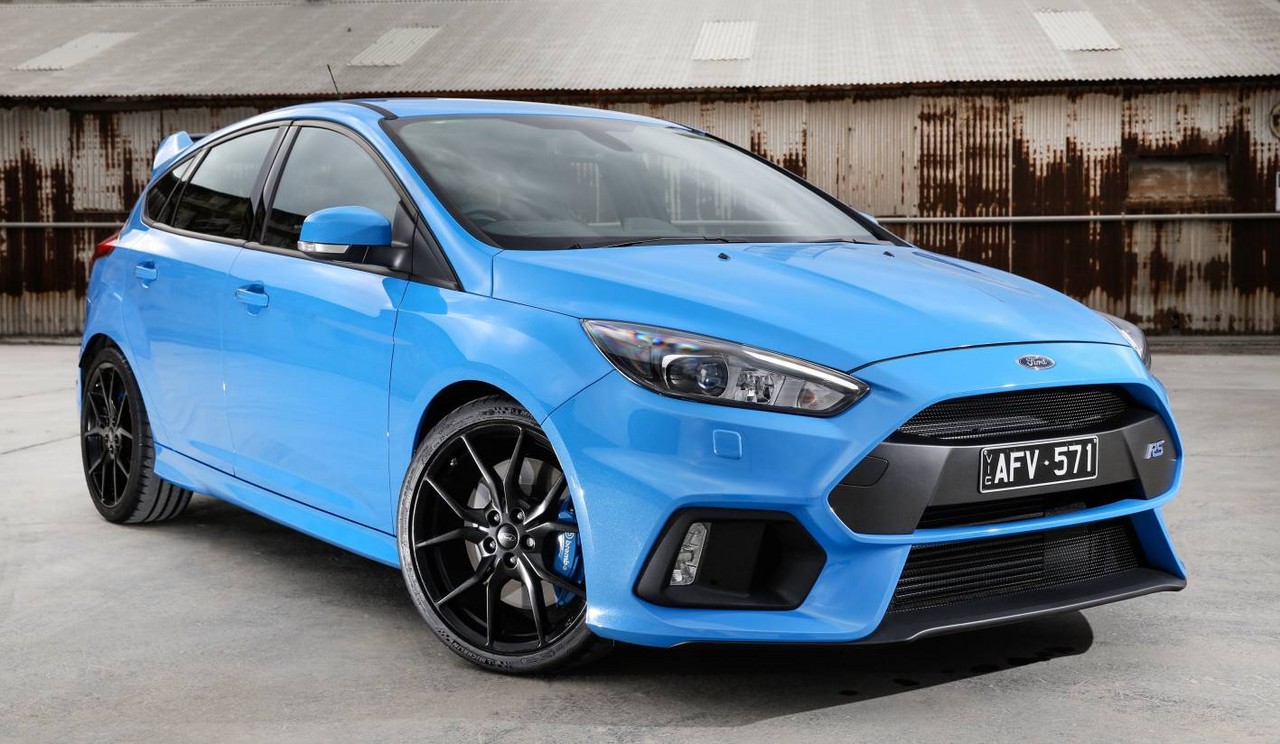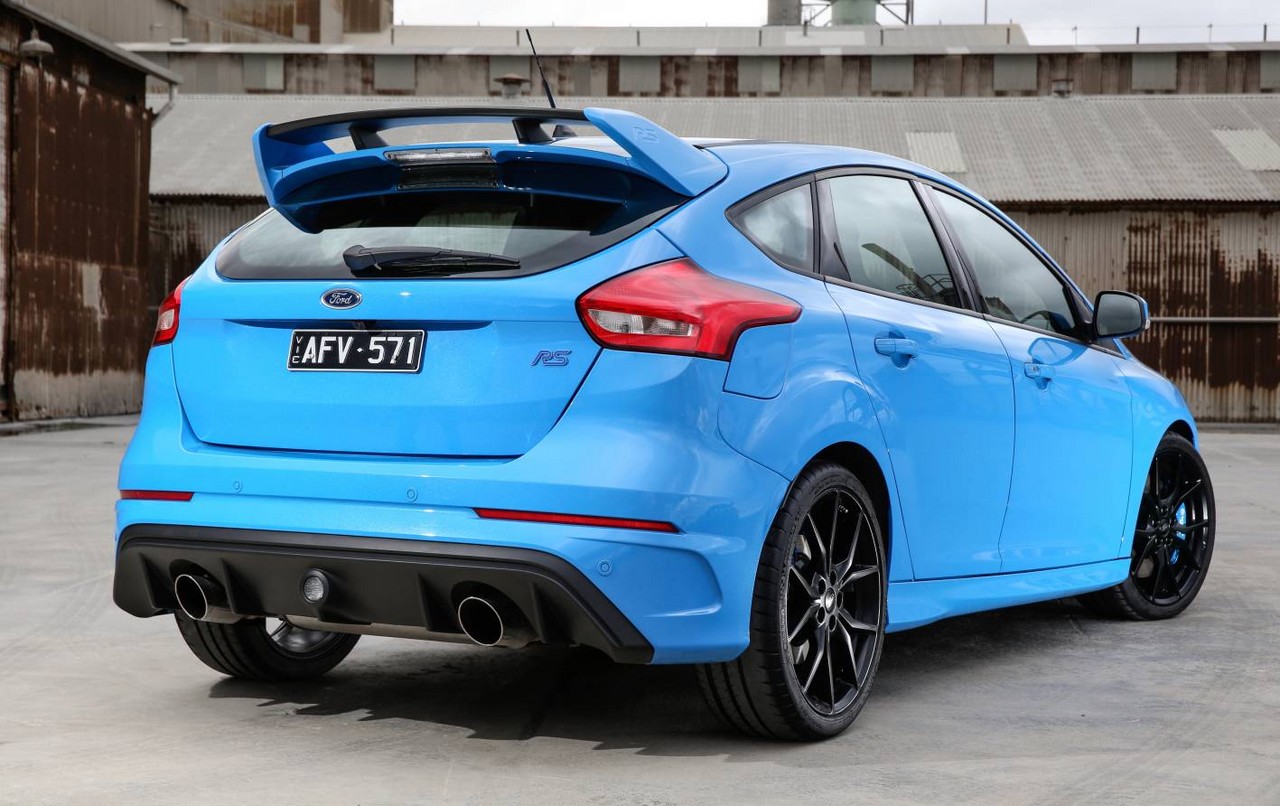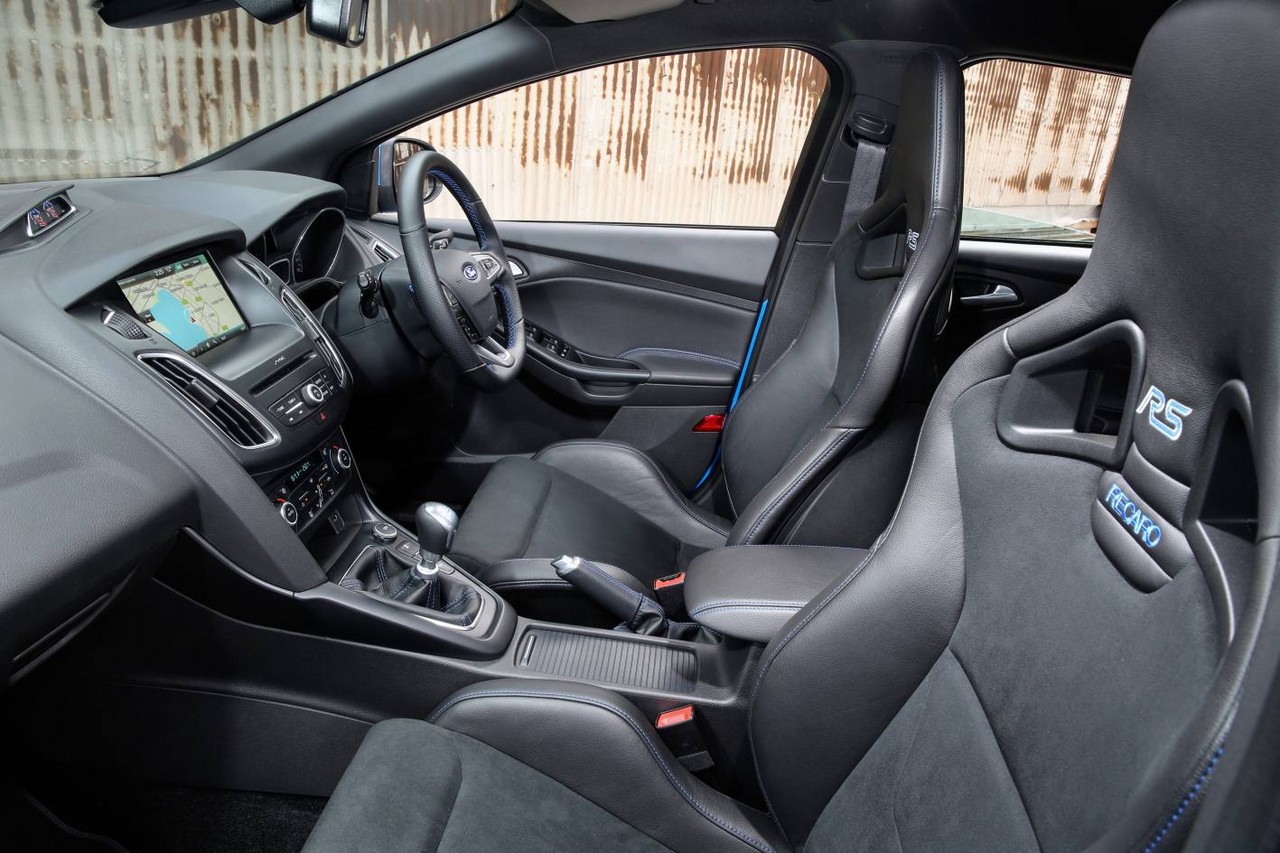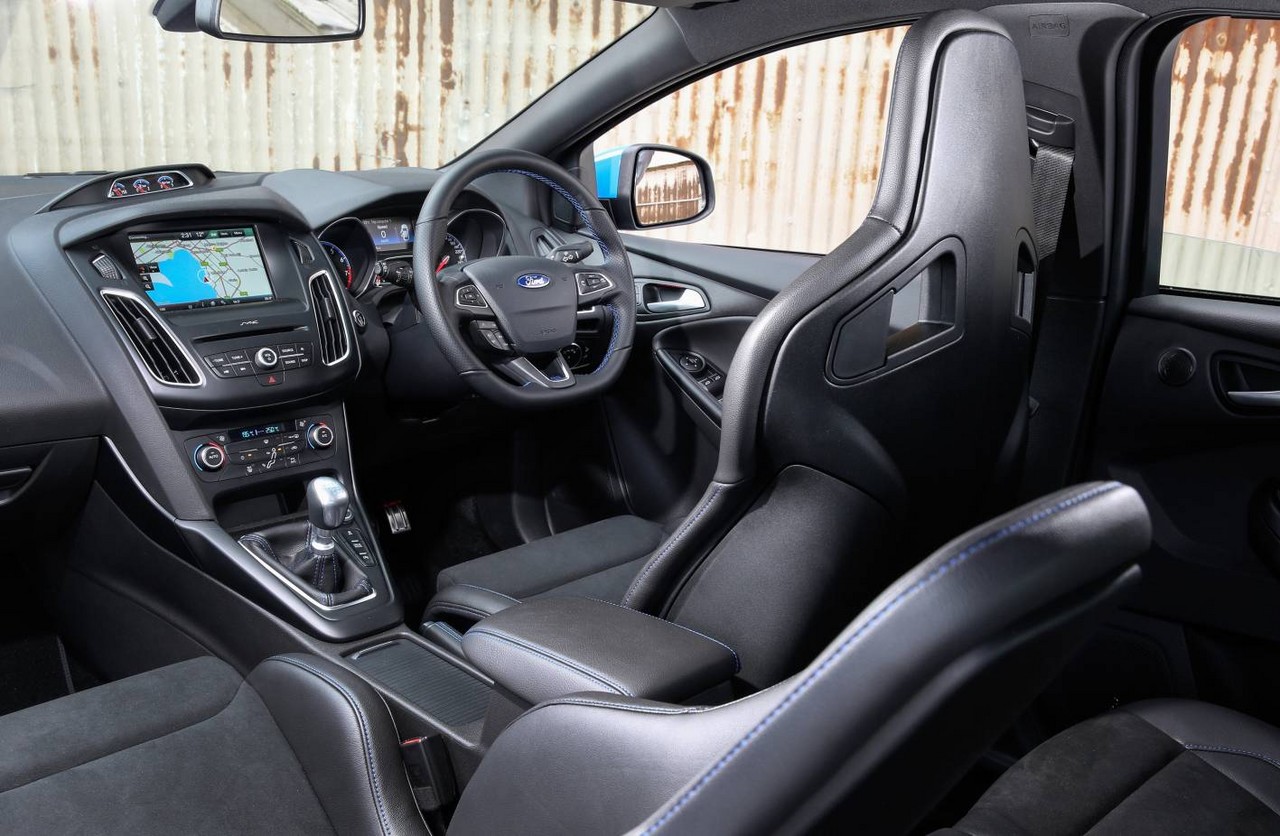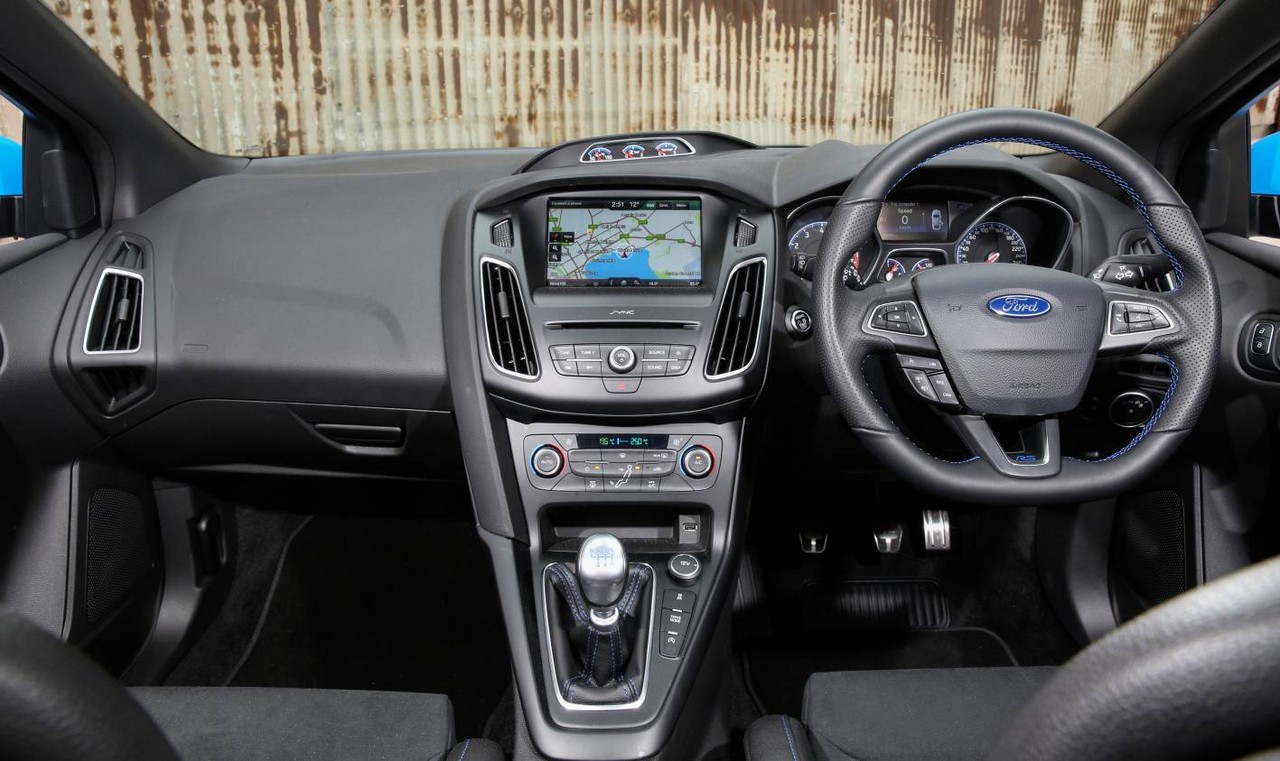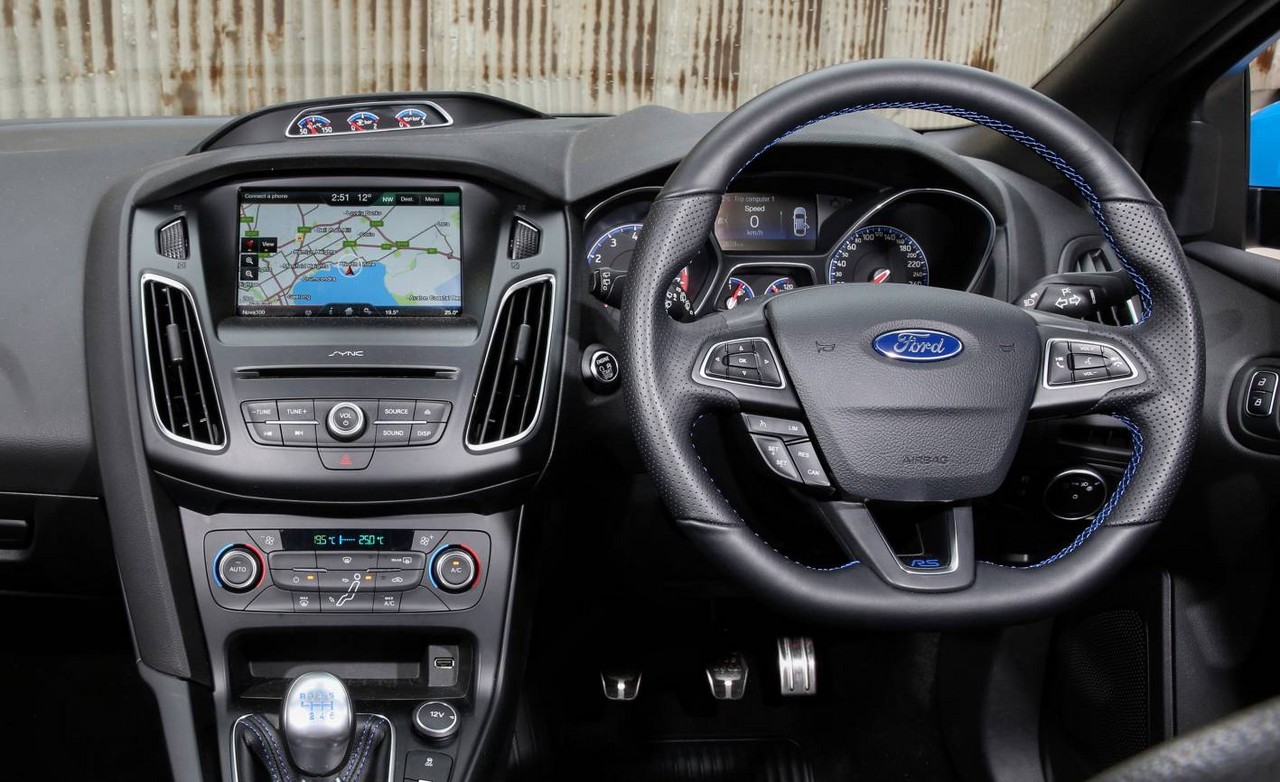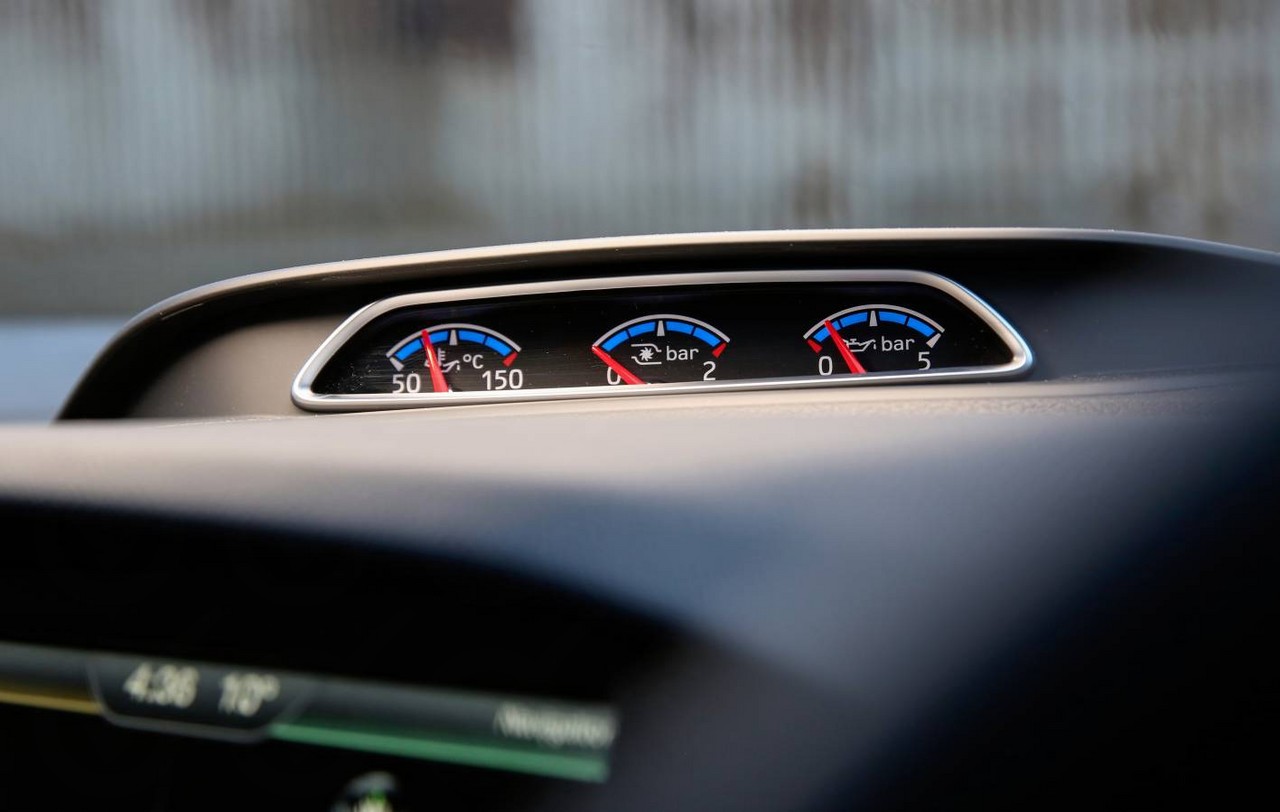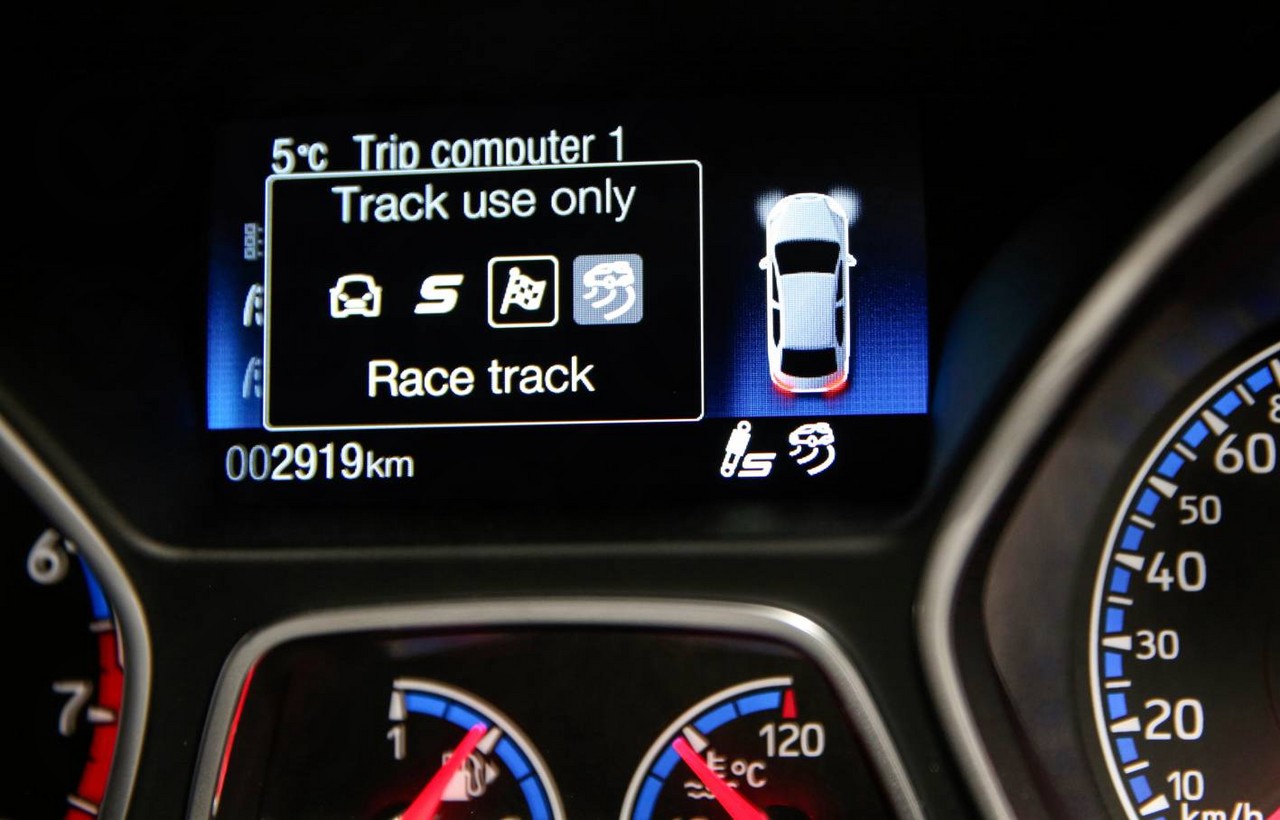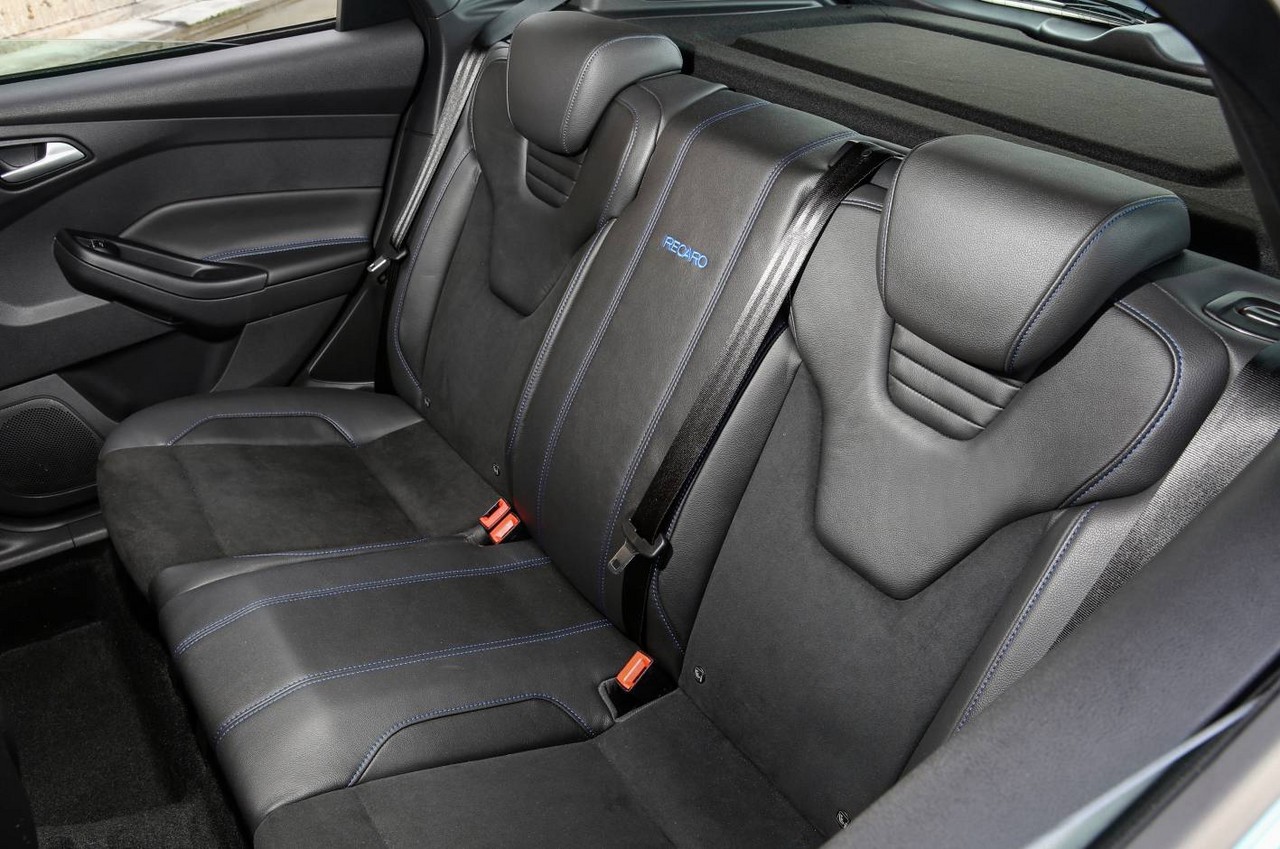
- Powerful 2.3-litre ‘EcoBoost’ engine
- All-wheel drive traction
- Excellent dynamics
- ???
Overview
Officially released in Australia in July 2016, the Ford LZ Focus RS was a three-door performance hatch. Commencing production in late 2015 in Saarlouis, Germany, the all-wheel drive Ford Focus RS was powered by a 2.3-litre turbocharged petrol engine that was mated to a six-speed manual transmission.
Focus RS: EcoBoost engine
Similar to the engine in the 2015 Ford Mustang , the 2261 cc four-cylinder turbocharged petrol engine for the Focus RS had an aluminium cylinder block with cast iron liners, a cast iron crankshaft which had eight counterweights and rotated on five main bearings, an aluminium alloy cylinder head, a low-inertia twin-scroll Honeywell (Garrett) turbocharger which provided peak boost pressure of 23.2 psi (1.6 bar), forged steel connecting rods, double overhead camshafts with twin independent variable camshaft timing (Ford’s Ti-VCT), four valves per cylinder, direct fuel injection at up to 200 bar, a compression ratio of 9.4:1 and Bosch MEDG17-I4 engine management. Furthermore, maximum engine speed was 6800 rpm and the engine complied with Euro 6 emissions standards.
Relative to the Mustang’s EcoBoost engine, however, the Focus RS had:
- Stronger, high-tensile cast iron liners for the cylinder block;
- A cylinder head produced from upgraded alloys which can withstand higher temperatures;
- A more robust head gasket with greater thermal capability;
- A larger compressor for the turbocharger;
- A larger intercooler for greater charge density;
- A larger radiator pack;
- A less restrictive air intake; and,
- A large-bore exhaust system with an electronically-controlled valve to control back pressure and noise.
While the Focus RS engine produced peak outputs of 257 kW and 440 Nm, though an overboost function can increase torque to 470 Nm for up to fifteen seconds. To reduce fuel consumption, the EcoBoost engine had an ‘Auto-Start-Stop’ function which enabled it to shut down when the vehicle was stationary in traffic.
| Engine | Trans. | Peak power | Peak torque | |
|---|---|---|---|---|
| Ford LZ Focus RS | 2.3-litre turbo petrol I4 | 6sp man. | 257 kW at 6000 rpm | 440 Nm at 2000-4500 rpm (470 Nm o’boost) |
Ford Performance All-Wheel Drive with Dynamic Torque Vectoring
The Ford Focus RS was fitted with Ford’s ‘Performance All-Wheel Drive with Dynamic Torque Vectoring’ system (manufactured by GKN Automotive). This all-wheel drive system utilised twin electronically-controlled clutch packs which were positioned on each side of the rear drive unit. These clutch packs were responsible for:
- The front:rear torque split; and,
- The left:right torque distribution for the rear wheels (which provided torque vectoring).
According to Ford, the control unit continuously varied the front:rear and rear wheel torque distributions according to the driving situation (based on inputs from sensors). Furthermore, up to 70 per cent of the engine’s torque could be directed to the rear axle and the rear wheel torque split was fully variable, i.e. up to 100 per cent of available torque at the rear axle could be sent to either rear wheel.
When cornering, the rear drive unit could pre-emptively divert torque to the outer rear wheel – based on inputs such as steering wheel angle, lateral acceleration, yaw and speed – to generate yaw and reduce understeer. The torque vectoring system was complemented by Ford’s ‘Torque Vectoring Control’ which could apply the brakes to individual wheels to generate yaw as required.
Launch Control and drive modes
The Focus RS had a Launch Control system which configured the vehicle’s chassis and powertrain systems for maximum acceleration. To activate, the driver selected ‘Launch Control’ from the cluster menu, engaged first gear, applied full throttle and then released the clutch. The Launch Control system then delivered optimum drive by distributing torque through the AWD system, maintaining maximum torque using the turbo overboost function, managing the traction control system and setting the dampers. As such, the Ford LZ Focus RS could accelerate from rest to 100 km/h in 4.7 seconds and had a top speed of 265 km/h.
For maximum acceleration, a gearshift indicator light in the instrument cluster alerted the driver when approaching the optimum upshift point of 5900 rpm and flashed if the engine hit its limit of 6800 rpm.
The Focus RS had four selectable drive modes – Normal, Sport, Track and Drift Mode – which configured the AWD system, damper controls, electronic stability control, steering, engine response and exhaust mode accordingly.
Dimensions and body
The Ford Focus RS was 4390 mm long, 1823 mm wide (excluding door mirrors), 1480 mm tall and had a 2648 mm long wheelbase; its kerb weight was 1575 kg.
Suspension and steering
The Focus RS had MacPherson strut front suspension and multi-link rear suspension, but with a more rigid front suspension knuckle, shorter link arms and unique spring rates, bushes and anti-roll bars than the standard Ford LZ Focus and Ford LZ Focus ST . The Focus RS also had two-mode switchable dampers which provide a firmer setting for track driving.
The Focus RS had rack-and-pinion steering with electric power assistance; the steering wheel required 2.0 turns from lock-to-lock, while the turning circle was 12.2 metres (wall to wall).
Safety equipment
Standard safety equipment for the Focus RS included dual front airbags, front seat-mounted side airbags, full-length curtain airbags, ABS, electronic brake force distribution, brake assist, electronic stability control, traction control and front seatbelts with pre-tensioners and load limiters.
As an extra-cost option, the Focus RS was available with Ford’s ‘Active City Stop’ system. Operating at speeds of up to 50 km/h, Active City Stop could automatically apply the brakes to mitigate or avoid a collision with a vehicle ahead. Generally, collisions at speeds of up to 15 km/h could be prevented and the severity of impacts between 15 km/h and 50 km/h reduced.
Brakes
The Ford Focus RS had 350 mm by 25 mm ventilated front brake discs with four-piston Brembo monoblock calipers (38 mm diameter) and 302 mm by 11 mm slid rear discs with a single-piston caliper (also 38 mm diameter).
Features: 2016 Ford Focus RS
Standard features for the Ford LZ Focus RS included 8.0J x 19-inch ‘RS’ alloy wheels finished in low-gloss black with 235/35 R19 Michelin Pilot Super Sport tyres, a Sony sound system with ten speakers (including a subwoofer), Ford’s ‘SYNC2’ connectivity system with an eight-inch touch screen, voice recognition, satellite navigation, Bluetooth mobile phone connectivity and audio streaming, dual-zone climate control air conditioning, Recaro front seats microfibre fabric panels, cruise control, directional bi-xenon headlights, LED daytime running lights, a rear view camera, a flat-bottomed steering wheel with a soft-feel leather rim, remote central locking and proximity key (i.e. keyless entry), power windows and heated mirrors, tilt and telescopic steering wheel adjustment, push-button start, alloy pedals, dashboard gauges (for boost pressure, oil temperature and oil pressure), tyre pressure monitoring, a trip computer, an alarm and an immobiliser.
Performance Wheel Pack
As an extra-cost option, the Focus RS was available with a ‘Performance Wheel Pack’ for $2,500 which consisted of 19-inch forged alloy wheels finished in a low gloss black colour and 235/35 R19 Michelin Pilot Sport Cup 2 tyres which were designed for racetrack use.
2017 Ford Focus RS Limited Edition
The Ford Focus RS Limited Edition was released in Australia in November 2017. Compared to the standard Ford Focus RS, the Focus RS Limited Edition was fitted with:
- 19-inch forged alloy wheels with 235/35 Michelin Pilot Sport Cup 2 tyres; and,
- A helical mechanical limited-slip front differential produced by RT Quaife Engineering .
As standard, the Focus RS Limited Edition was equipped with Ford’s ‘Active City Stop’ (Autonomous Emergency Braking) system. Inside, the Focus RS had Recaro shell seats that featured ‘Nitrous Blue’ leather trim. Visually, the Focus RS could be identified by its ‘Nitrous’ blue prestige paint finish, privacy glass and gloss black finishes for the door mirror caps, roof and rear spoiler.
The Focus RS Limited Edition had a manufacturer’s list price (MLP) of $56,990 (excluding on-road costs) and Australian deliveries were limited to 500 vehicles.
Pricing and paint finishes
Upon its release in Australia, the Ford Focus RS had a Manufacturer’s List Price (MLP) of $50,990 (did not include on-road costs such as dealer delivery, stamp duty, registration and, where required, CTP). Furthermore, the Focus RS was available in White, Nitrous (blue), Magnetic (grey) and Shadow Black paint finishes; of these, only White was not regarded as a ‘Prestige’ paint finish such that the other finishes cost an additional $450.
Brochures and specifications
- Brochure: Ford Focus RS – Australia (October 2015)
- Specifications: Ford Focus RS – EU (January 2016)
- Behind the Wheel: 2017 Ford Focus RS Review
